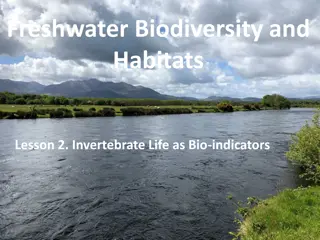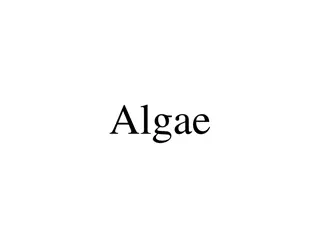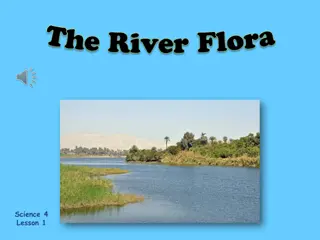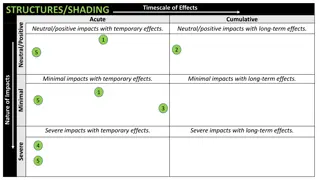Identification of Aquatic Plants in Freshwater Bodies Based on Habitat Classification
Before identifying aquatic plants in freshwater bodies, it's vital to classify them into floating macrophytes, marginal macrophytes, submerged macrophytes, and emergent macrophytes. This classification aids in distinguishing various plant species such as Eichhornia, Salvinia, Pistia, Lemna, and Azolla. Each plant has unique characteristics and adaptations to its aquatic environment, contributing to the diversity of freshwater ecosystems.
Download Presentation

Please find below an Image/Link to download the presentation.
The content on the website is provided AS IS for your information and personal use only. It may not be sold, licensed, or shared on other websites without obtaining consent from the author.If you encounter any issues during the download, it is possible that the publisher has removed the file from their server.
You are allowed to download the files provided on this website for personal or commercial use, subject to the condition that they are used lawfully. All files are the property of their respective owners.
The content on the website is provided AS IS for your information and personal use only. It may not be sold, licensed, or shared on other websites without obtaining consent from the author.
E N D
Presentation Transcript
Identification of aquatic plants from different freshwater bodies
Before identification of these plants, they must be classified based on their habitat into the following classifications, they are : i. Floating macrophytes ii. Marginal macrophytes iii. Submerged macrophytes iv. Emergent macrophytes
i. Floating macrophytes 1. Eichhornia sp (Water hayacinth or blue devil) Class : Angiosperm Family : Pontederiacea It is native of Brazil, accidentally brought to India and released in West Bengal, one of the most damaging aquatic weeds, inhabits stagnant and slow moving rivers. Leaves broad with swollen stalks filled with air to enable them to float on water surface, dense leathery roots, flower multiplication by vegetative propagation, dries off in winter and spourts during summer. pinkish in colour,
2. Salvinia (water fern velvet) Family : Salviniaceae This plant has got rhizome, stalk or stem is delicate, oblong or hemispherical leaves, actual roots absent, leaves sessile with short stalk, leaves in two or more whorls, second whorl is either lateral and floating, third one submerged in water which looks like roots, lateral leaves sometimes filled with air which aids in floating.
3. Pistia (water lettuce) Family : Araceae A free floating perennial plant, plant body comprise a shell like rosette of tongue shaped leaves, reduced stem, sessile leaves and numerous branching roots, leaves form common cup shaped structure, surrounded at the base by membranous sheath. leaves ovate and
4. Lemna (duck weed) Light green in colour, occurs in group of one to three, no distinct stem, leaves have flattened, minute leaf-like fronds, vegetative reproduction is rapid, often forming a scum over the surface, flowers are rare and so small that they are invisible to naked eye, appear as small weeds.
5. Azolla (water velvet) Family : Azollaceae Smaller plant, found in stagnant water bodies, leaves lobed, scale like, thick and about 0.5 mm in length, the entire plant is 1.5 2.0 cms in length, impart reddish green colour to water surface by covering it, it fixes atmospheric nitrogen.
Marginal macrophytes Typha (Cat tail or Elephant grass) Family : Typhaceae Common in margins of ponds, lakes, rivers and canals, perennial, creeping rhizome with leaves growing up to 2 m height and leaves have sheath at the base. Leaves bi-serrate, thick and spongy, secreting organ present at the leaf base, flower numerous and cylindrical.
Scirpus (Bullrush) Family : Cyperaceae Annual herb, triangular in cross section, stem bears sheath at the base but sometimes leafy and naked, spiklets numerous with one or more long leaves from the base of branch, spiklets are usually with more flowers.























